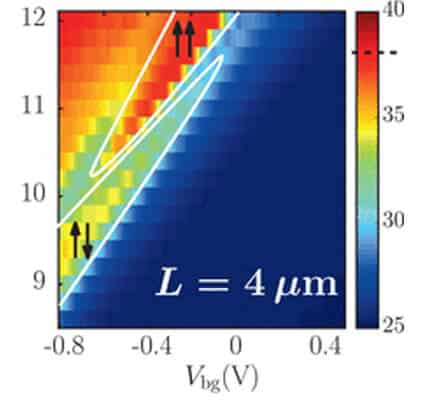Weizmann Institute of Science scientists observed for the first time groups of electrons that function as "simulated particles" as they move against the current in the fractional quantum Hall system

An electrical resistance greater than zero was measured in a non-polarized fractional quantum Hall system, as a result of particles moving against the current. Illustration, Prof. Motty Highblom, Weizmann Institute
A driver who made a mistake at the interchange and found himself driving on the highway, against the direction of traffic, receives a phone call from his wife: "Be careful", she tells him, "on the radio they are reporting that there is a reckless driver, who is driving against the direction of traffic." "Just one of these?" He answers her, "There are a lot of them here..."
Movement against the direction of the normal, main current is always a difficult matter, but it is usually attributed to human beings and the rebellious nature of some of them. Electrons, on the other hand, are expected to behave regularly, so that all electrons in a particular system move in the same orbits. But it turns out that even in the tiny world of electrons, situations may arise where most of the electrons move in one direction, while some of them move against the general direction of flow. This phenomenon was recently discovered in an experiment carried out by research students Amir Rosenblatt and Fabian Lafont, staff scientist Vladimir Omansky and Prof. Moti Hayblum at the Weizmann Institute of Science.
The observation was made in the fractional quantum Hall system. The Hall effect occurs when a system, in which electrons are moving, is subjected to the influence of a magnetic field perpendicular to the plane of motion of the electrons. As a result, the electrons are "pushed" from the center of the system and continue to move on its edge. Under certain conditions, the system becomes "fractional", that is, even though it is an electronic system, in which particles - electrons - with the same negative electrical charge move, "particles" are created in it whose charge is a fraction of the electron's charge. These particles are, in fact, a kind of structures (or groups) of electrons that function as "simulated particles" ("quasi-particles"), each of which carries an electric charge smaller than the "basic" charge of a single electron: one third of the electron's charge, one fifth or A seventh of it, and more.
According to a certain theory, in the system of the fractional quantum Hall effect, in which virtual particles with an electric charge equal to two-thirds of the electron's charge are created - "virtual holes" with a fractional positive electric charge are also supposed to be created. "Holes" are a kind of "spaces" left behind by electrons that jumped to another state. The "hole", or the "lack of an electron" (or, if you want, a kind of "overdraft"), functions as a particle. Since the electron has a negative electric charge, the "lack of an electron" has the opposite electric charge - that is, positive. These "holes", which have the positive electric charge, should, according to the theory, move on the edge of the system in the opposite direction to that of the simulated fragmentary particles.
In the past, scientists in different parts of the world tried to notice this reverse current, but were unable to observe it or measure it. Institute scientists recently succeeded in doing this. The experiment that led to success was carried out in the fractional quantum Hall system, in which simulated particles with a charge equal to two-thirds of the electron's charge are created, and in which the current is not magnetically polarized (in the past, scientists tried to distinguish the "hole current" moving in the opposite direction, in systems where polarization existed). The construction of a suitable experimental system, in which polarization does not exist, required careful and strict planning, and construction on semiconductor chips with defined and unique properties that are difficult to create. This is where staff scientist Dr. Vladimir Umansky, who is a world-renowned expert in creating unique crystals in semiconductors, comes into the picture. Dr. Umansky created crystals that allowed the members of the research group to build the experimental system in which they were able to measure the "current of holes", which moves in the opposite direction to the direction of the electron current.
The "current of holes", moving in the opposite direction, was much weaker than the normal current of electrons (about a tenth of it), and it weakened to the point of disappearance, depending on the distance of movement. That is, it is a phenomenon that occurs in the movement of charged particles for a tiny distance - up to about four micrometers. Still, this experimental result's significant support for the theory advances our ability to better understand the set of laws that govern the world of quantum particles.

4 תגובות
I don't know a fractional Hall system, but a flow of holes in the opposite direction of the electrons is a well-known phenomenon, recognized and measured, for decades in semiconductors. With the help of this stream, any computer or smart phone works...
Quote from the quantum Hall effect on Wikipedia: Robert Leflin, Horst Sturmer and Daniel Tsui won the Nobel Prize in Physics in 1998 for the discovery and explanation of the fractional quantum Hall effect.
So what, they received a Nobel Prize without observing and measuring the effect and only now did the Weizmann Institute succeed in doing so?
It's a shame that it was not stated when for the first time they predicted the phenomenon theoretically and for how long they tried to reproduce it in laboratory conditions, but overall a very interesting article.
MRTK!